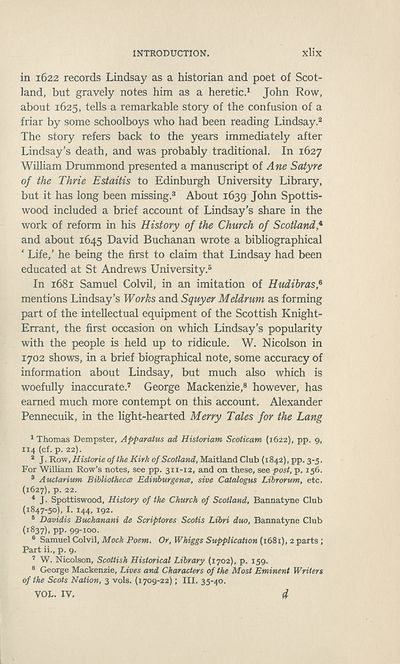Scottish Text Society publications > Third series > Works of Sir David Lindsay of the Mount, 1490-1555 > Volume 4, 1936
(51)
Download files
Complete book:
Individual page:
Thumbnail gallery: Grid view | List view

INTRODUCTION.
xlix
in 1622 records Lindsay as a historian and poet of Scot¬
land, but gravely notes him as a heretic.1 John Row,
about 1625, tells a remarkable story of the confusion of a
friar by some schoolboys who had been reading Lindsay.2
The story refers back to the years immediately after
Lindsay’s death, and was probably traditional. In 1627
William Drummond presented a manuscript of Ane Satyre
of the Thrie Estaitis to Edinburgh University Library,
but it has long been missing.3 About 1639 John Spottis-
wood included a brief account of Lindsay’s share in the
work of reform in his History of the Church of Scotland*
and about 1645 David Buchanan wrote a bibliographical
‘ Life,’ he being the first to claim that Lindsay had been
educated at St Andrews University.5
In 1681 Samuel Colvil, in an imitation of Hudibras,6
mentions Lindsay’s Works and Squyer Meldrum as forming
part of the intellectual equipment of the Scottish Knight-
Errant, the first occasion on which Lindsay’s popularity
with the people is held up to ridicule. W. Nicolson in
1702 shows, in a brief biographical note, some accuracy of
information about Lindsay, but much also which is
woefully inaccurate.7 George Mackenzie,8 however, has
earned much more contempt on this account. Alexander
Pennecuik, in the light-hearted Merry Tales for the Lang
1 Thomas Dempster, Apparatus ad Historiam Scoticam (1622), pp. 9,
114 (cf. p. 22).
2 J. Row, Historie of the Kirk of Scotland, Maitland Club (1842), pp. 3-5.
For William Row’s notes, see pp. 311-12, and on these, see post, p. 156.
3 Auctarium Bibliotheca Edinburgena, sive Catalogue Librorum, etc.
(1627), p. 22.
4 J. Spottiswood, History of the Church of Scotland, Bannatyne Club
(1847-50), I. 144, 192.
5 Davidis Buchanani de Scriptores Scotis Libri duo, Bannatyne Club
(i837). PP- 99-ioo.
6 Samuel Colvil, Mock Poem. Or, Whiggs Supplication (1681), 2 parts ;
Part ii., p. 9.
7 W. Nicolson, Scottish Historical Library (1702), p. 159.
8 George Mackenzie, Lives and Characters of the Most Eminent Writers
of the Scots Nation, 3 vols. (1709-22); III. 35-40.
VOL. IV. d
xlix
in 1622 records Lindsay as a historian and poet of Scot¬
land, but gravely notes him as a heretic.1 John Row,
about 1625, tells a remarkable story of the confusion of a
friar by some schoolboys who had been reading Lindsay.2
The story refers back to the years immediately after
Lindsay’s death, and was probably traditional. In 1627
William Drummond presented a manuscript of Ane Satyre
of the Thrie Estaitis to Edinburgh University Library,
but it has long been missing.3 About 1639 John Spottis-
wood included a brief account of Lindsay’s share in the
work of reform in his History of the Church of Scotland*
and about 1645 David Buchanan wrote a bibliographical
‘ Life,’ he being the first to claim that Lindsay had been
educated at St Andrews University.5
In 1681 Samuel Colvil, in an imitation of Hudibras,6
mentions Lindsay’s Works and Squyer Meldrum as forming
part of the intellectual equipment of the Scottish Knight-
Errant, the first occasion on which Lindsay’s popularity
with the people is held up to ridicule. W. Nicolson in
1702 shows, in a brief biographical note, some accuracy of
information about Lindsay, but much also which is
woefully inaccurate.7 George Mackenzie,8 however, has
earned much more contempt on this account. Alexander
Pennecuik, in the light-hearted Merry Tales for the Lang
1 Thomas Dempster, Apparatus ad Historiam Scoticam (1622), pp. 9,
114 (cf. p. 22).
2 J. Row, Historie of the Kirk of Scotland, Maitland Club (1842), pp. 3-5.
For William Row’s notes, see pp. 311-12, and on these, see post, p. 156.
3 Auctarium Bibliotheca Edinburgena, sive Catalogue Librorum, etc.
(1627), p. 22.
4 J. Spottiswood, History of the Church of Scotland, Bannatyne Club
(1847-50), I. 144, 192.
5 Davidis Buchanani de Scriptores Scotis Libri duo, Bannatyne Club
(i837). PP- 99-ioo.
6 Samuel Colvil, Mock Poem. Or, Whiggs Supplication (1681), 2 parts ;
Part ii., p. 9.
7 W. Nicolson, Scottish Historical Library (1702), p. 159.
8 George Mackenzie, Lives and Characters of the Most Eminent Writers
of the Scots Nation, 3 vols. (1709-22); III. 35-40.
VOL. IV. d
Set display mode to: Large image | Zoom image | Transcription
Images and transcriptions on this page, including medium image downloads, may be used under the Creative Commons Attribution 4.0 International Licence unless otherwise stated. ![]()
| Publications by Scottish clubs > Scottish Text Society publications > Third series > Works of Sir David Lindsay of the Mount, 1490-1555 > Volume 4, 1936 > (51) |
|---|
| Permanent URL | https://digital.nls.uk/107275487 |
|---|
| Shelfmark | SCS.STES3.8 |
|---|---|
| Attribution and copyright: |
|
| Description | A collection of over 100 Scottish texts dating from around 1400 to 1700. Most titles are in Scots, and include editions of poetry, drama, and prose by major Scottish writers such as John Barbour, William Dunbar, Gavin Douglas, and George Buchanan. Edited by a key scholarly publisher of Scotland's literary history, and published from the late 19th century onwards by the Scottish Text Society. Available here are STS series 1-3. |
|---|

